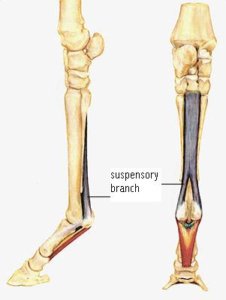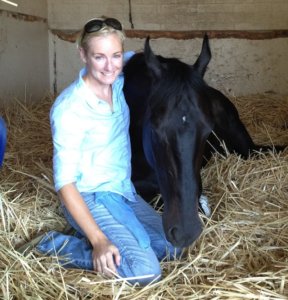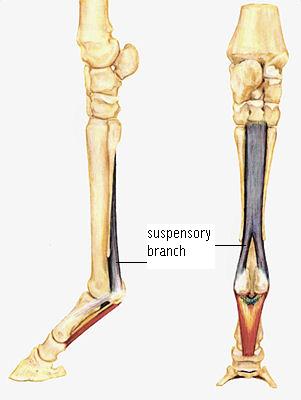Part 1: Treating a Suspensory Branch Lesion with Platelet Rich Plasma
by Jennifer Finley, DVM, Ph.D.
Ligaments are a dense fibrous connective tissue with a complex structural hierarchy, which permits plastic deformation under high tensile loads such as racing at speed or Grand Prix-level jumping. When exercise levels exceed the yield point of the ligament, or repetitive loading creates damage to the ligament over time at a rate that exceeds the cells’ ability to keep up with repair, damage becomes clinically apparent.

Inflammation of a ligament (desmitis) and tearing of the medial or lateral branch of the suspensory ligament of the forelimb or hindlimb is a relatively common injury in all types of sport horses. Although both branches have the potential to be affected, usually it is only a single branch in a single limb.
The degree of damage and chronicity of the lesion dictates the clinical signs. Most commonly the signs include heat and swelling, often due to enlargement of the branch as well as associated periligamentous edema or fibrosis. Flexion of the fetlock or direct pressure to the branch will elicit a pain response. Lameness may or may not be present without distal limb flexion depending on the circumstances of the injury. An ultrasound exam and local analgesic techniques are used to confirm the clinical signs. Abnormalities observed on the ultrasound potentially include enlargement of the branch; change in the shape of the branch; loss of definition of the branch margins; and central or peripheral hypoechogeneic (appearing black on the ultrasound) areas. The following case study is an example of the effective use of platelet-rich plasma (PRP) to aid in healing this sort of injury.
History
A 6-year-old Thoroughbred racehorse was noted to be acutely lame following a race. Upon evaluation, he was grade 3/5 lame (lame with a notable head nod) on the right forelimb at a jog in a straight line. He had significant swelling over the lateral aspect of the right forelimb extending from the distal third of the cannon to the bottom of the fetlock. He exhibited pain on palpation over the lateral aspect of the fetlock on the right, and resented flexion at that location. Ultrasound examination revealed inflammation and a tear in the lateral branch of the suspensory ligament.
The cause and subsequent development of an abnormal condition or disease of a ligament injury ultimately is dynamic and complex. Mechanical injuries are likely to play a central role, along with hyperthermia of the core of the ligament or poor blood flow to the area. Ligaments, like tendons, are metabolically very active, causing them to, at times, have an inappropriate healing response to an injury. The unfortunate result leaves the final composition and organization of the tissue unable to withstand the tensile forces required to return to a similar level of performance.
Following initial treatment with anti-inflammatories and cold therapy to address the acute stages of the injury, this horse underwent intralesional therapy (direct therapeutic injections into a lesion) with platelet-rich plasma, or PRP, in an attempt to steer the healing process in a healthy and productive direction.
Platelet Rich Plasma (PRP)
PRP was originally reported in 1997 to accelerate tissue regeneration in oral surgery and has since provided therapeutic benefits in fields ranging from cardiothoracic surgery to orthopedics. Wound healing involves a complex array of molecular events. Platelets play a prominent role in wound healing and are activated by exposure to damaged tissue. In this environment, platelets release numerous growth factors that are known to enhance cell division, matrix production and other beneficial characteristics of healing.
The basic therapeutic theory of PRP is this: a wound is treated with a provisional matrix containing a higher concentration of the proteins responsible for healing than would be provided naturally by the activation of whole blood. Intralesional injection of PRP will increase type I collagen production, tenocyte (tendon cell) production and neovascularization. This will lead to increased early strength, organization and fiber pattern alignment, with the ultimate goal of the ligament healing with more elasticity and less scar formation.
Stay tuned! The procedure, rehabilitation program and outcome for this horse will be discussed next month.

Jennifer Finley, DVM, Ph.D., joined Pilchuck’s team of equine veterinarians in September 2012. She has more than five years of experience providing advanced veterinary care to performance horses. Dr. Finley focuses her practice within PVH’s Equine Performance Sports Medicine Institute. Dr. Finley received a B.S. in public health and Ph.D. in pathology from the University of Washington. She went on to pursue her DVM from Washington State University, earning her degree in 2007.
Pilchuck Veterinary Hospital’s new Equine Performance Sports Medicine Institute marks the latest milestone in the hospital’s 50-year history. A dedicated facility on Pilchuck’s campus, the Institute is led by James Bryant, DVM, DACVS. Just like their human counterparts, equine athletes often require specialized, advanced diagnostics and therapies. The Institute’s goals are to provide an accurate and timely diagnosis of performance-limiting conditions, and to devise a custom treatment plan to allow for recovery of the injury and maintenance of soundness afterward. For more information visit pilchuckvet.com.
Published March 2013 Issue

The Colorado Horse Source is an independently owned and operated print and online magazine for horse owners and enthusiasts of all breeds and disciplines in Colorado and surrounding area. Our contemporary editorial columns are predominantly written by experts in the region, covering the care, training, keeping and enjoyment of horses, with an eye to the specific concerns in our region.

